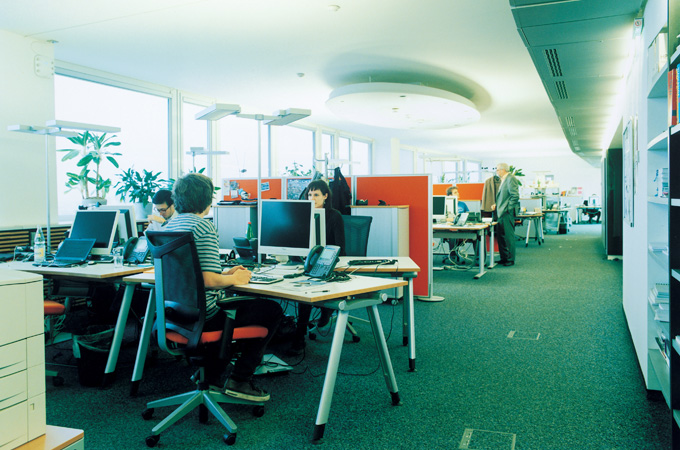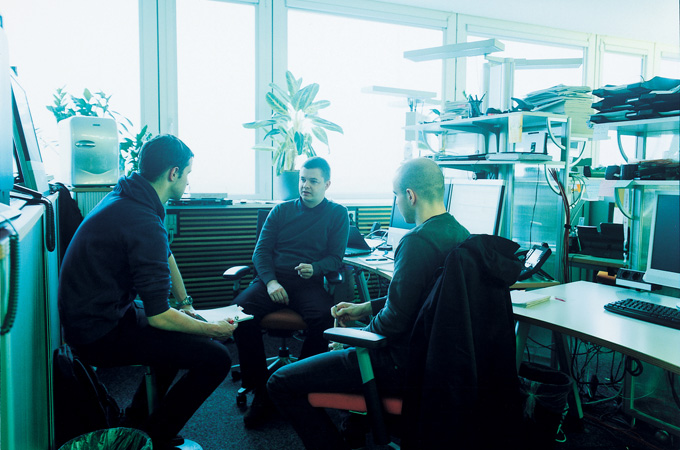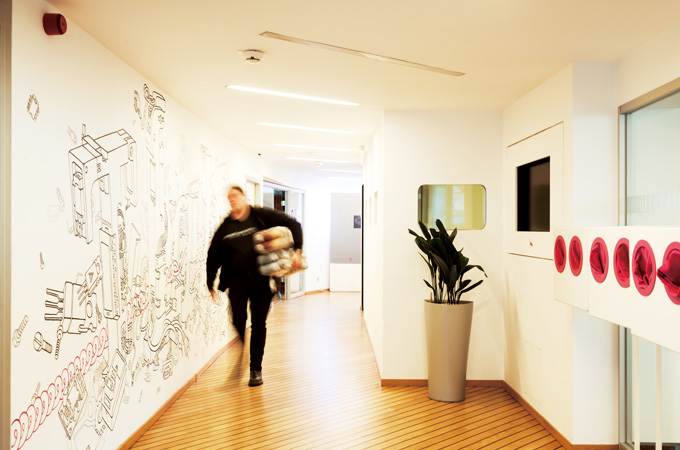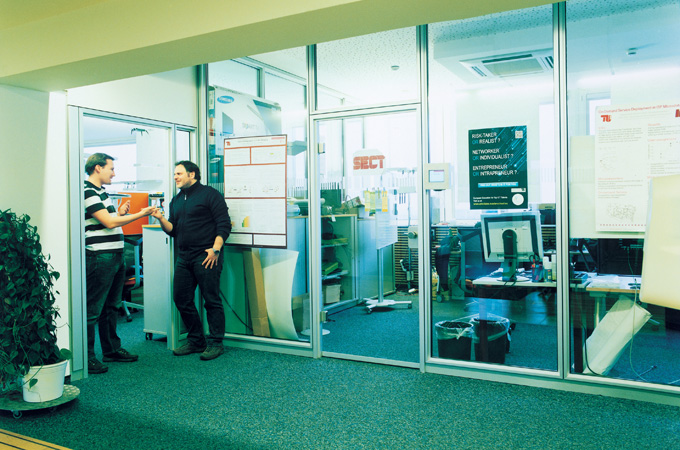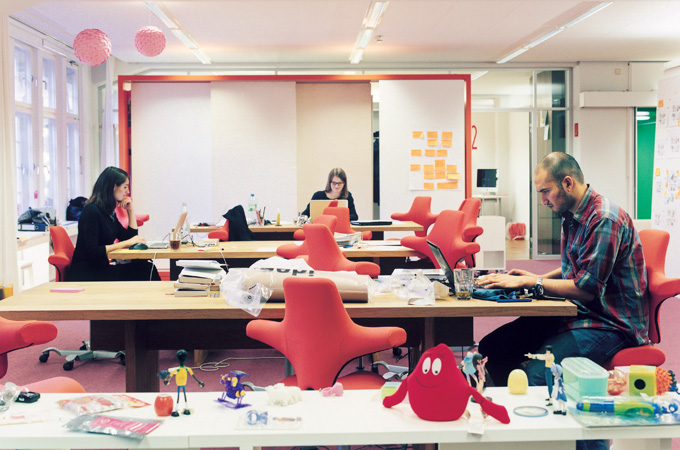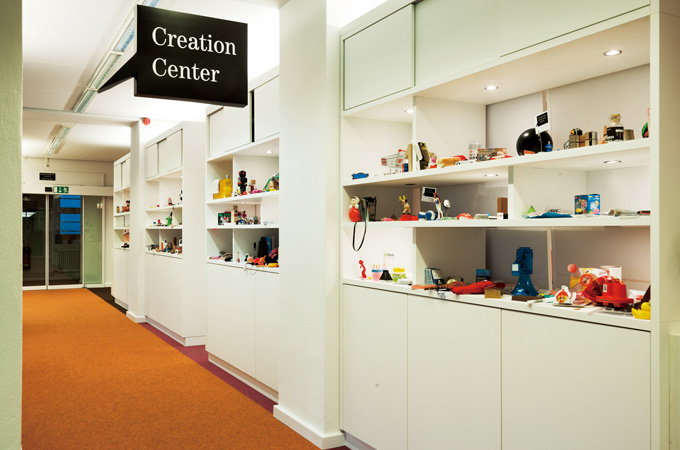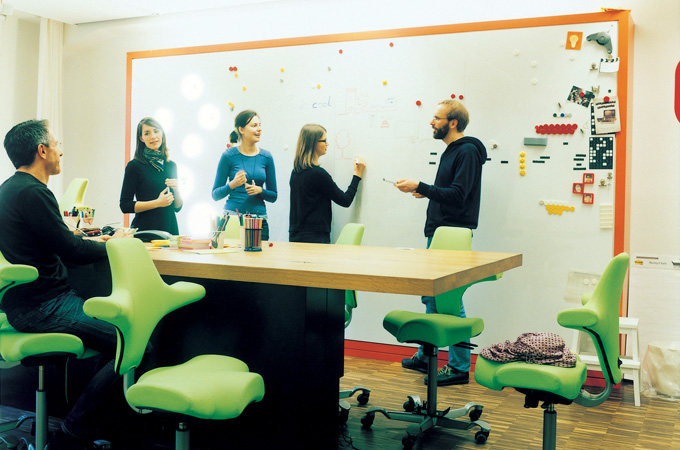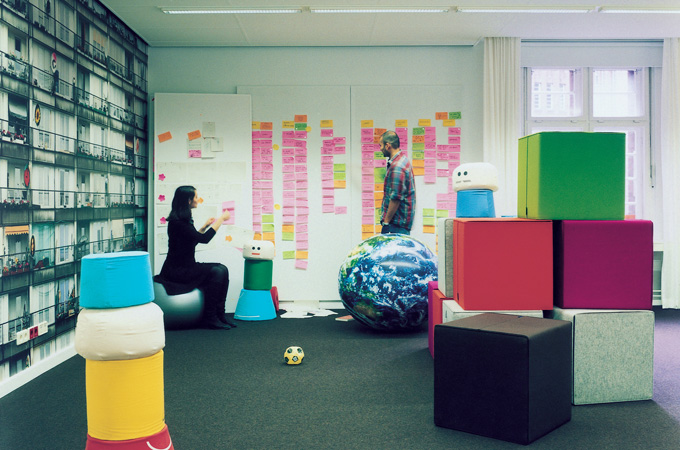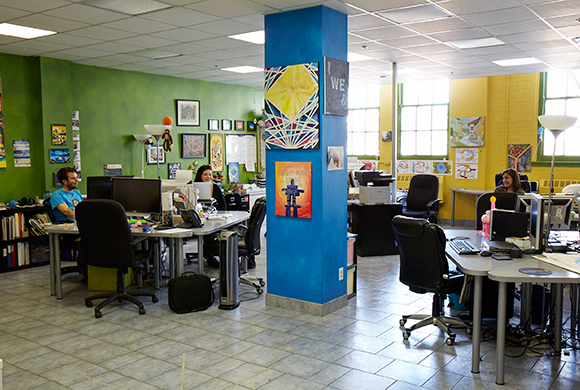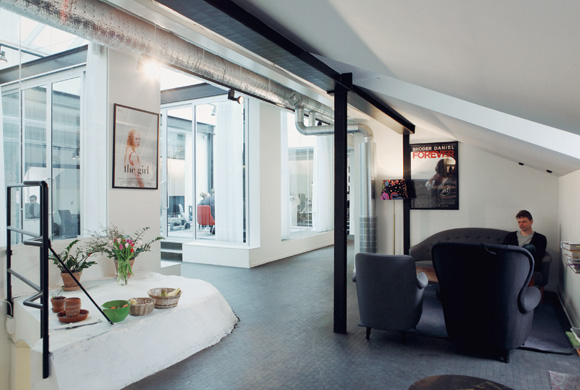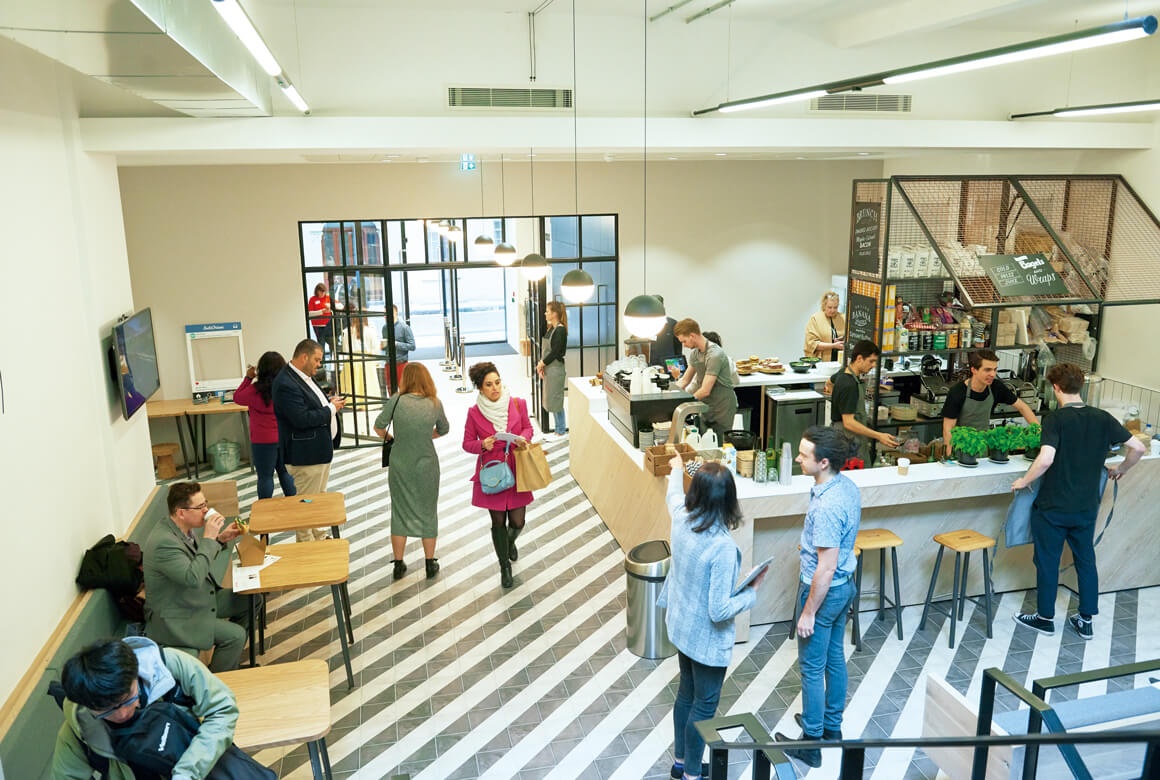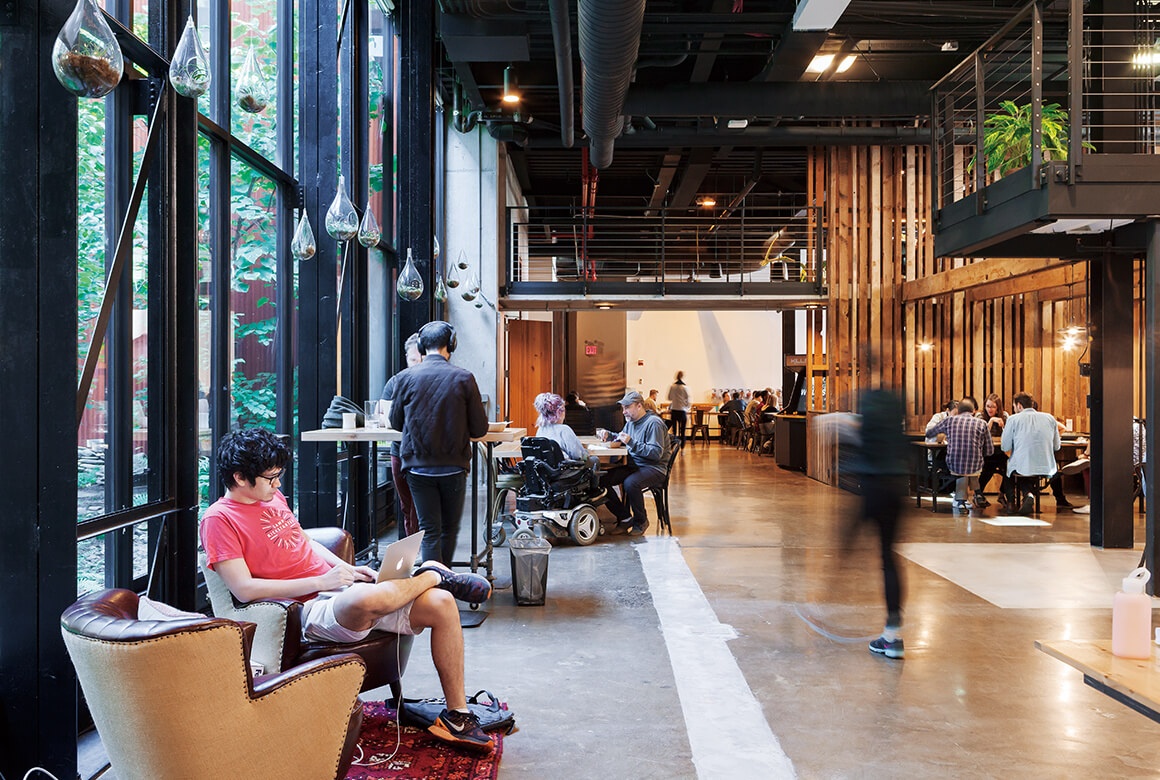Workplace
Nov. 7, 2016
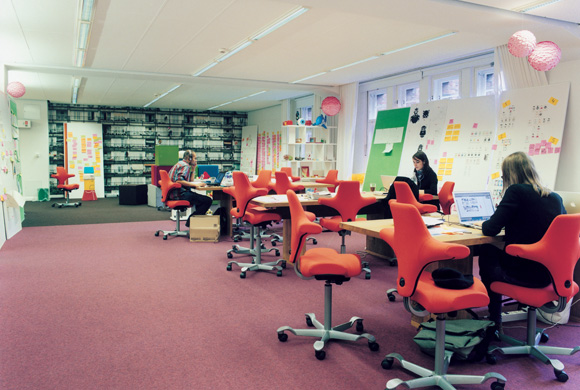
Unique Approach to Innovation:
In-House Innovation
An R&D organization to match in-house technologies and user needs
[Deutsche Telekom AG] Berlin, Germany
Deutsche Telekom, Europe’s largest telecommunications company, has interesting approaches to innovation.
T-Labs takes a academic viewpoint in conducting R&D activities and works in cooperation with the Technical University of Berlin. Its office is located in a building of the University. Approximately there are 360 employees in the office; a half of them are Deutsche Telekom employees, the other half are the university personnel. Six professors are also permanently appointed to work there. It is an industry-university cooperative organization linked with close ties. One of the issues T-Labs is working on is how companies can add innovation to the existing technology at lower cost and faster.
In Creation Center, experts and users are closely involved in the research and analysis of the hidden needs and expectations of consumers. They support and carry out the concept-making of new services. Creation Center is a division of T-Labs. Most of the people involved in the projects are not in creative jobs, so the office space is designed to stimulate their inspiration and filled with fun items.
Each place takes their own role and method towards innovation. While T-Labs continuously propose and discuss all kinds of innovation, Creation Center works on the improvement of current projects, the process of design thinking and future scripts.
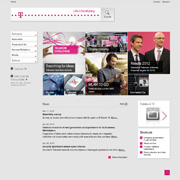 Founded: 1995(through privatization)
Founded: 1995(through privatization)
Revenue: €58.65 billion(in 2011)
Employees: 235,132(in 2011)
http://www.telekom.com/
T-Labs: An innovation laboratory in cooperation with the Technical University of Berlin
Deutsche Telekom’s internal innovation laboratory, T-Labs, was founded in 2004. It is an industry-academia cooperative organization with the Technical University of Berlin. “Originally, Deutsche Telekom’s business organization was not quite set for innovation,” says Herman Hartenthaler, Senior Project Manager. In a commercial company, direct and obvious results are required even to the R&D department. Naturally, ideas and prototypes are not always to become final products. It is very difficult to bring out successful results constantly. However, by collaborating with the university and sharing the process in regards to R&D, they can achieve effective cost and equally effective speed. This combination of Deutsche Telekom’s technological strength and academic imput from the Technical University is what makes T-Labs exceptional.
Projects are mostly related to Deutsche Telekom’s business departments. One of the ongoing projects is the development of inflight mobile phone call technology. Another is the development of a 200-channel home internet TV service.
Most of the projects are brought in from Deutsche Telekom, but anyone who has an idea can make a proposal. Proposals can also come from the university. Each week, the T-Lab staff get together to discuss the pros and cons of ideas, business models and cost. The final decision as to whether the idea will be taken on as a project is made by the Deutsche Telekom’s business team. “About 20 to 25 percent of our budget are used for high-risk study,” Mr. Hartenthaler says. This is to develop the organization beyond its current state and further in the market.
There are about 360 employees in the office; a half belongs to Deutsche Telekom, and another to the Technical University of Berlin. In the workspace, desk-sharing is common so people can choose wherever they want and need to work and this makes collaboration smoother. With the excellent network functions from lighting level to telephone diversion, the staff can create the best working environment for themselves everywhere in the office. The cafeteria, the kitchen and the living room are to encourage communication among the staff who have different backgrounds. A new idea for innovation can often be born out of spontaneous communication.
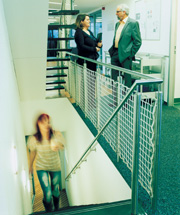 The building shape looks something like a ship, while the office design uses a boat motif.
The building shape looks something like a ship, while the office design uses a boat motif.
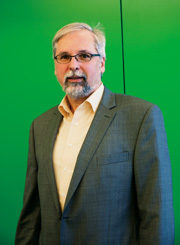 Herman Hartenthaler
Herman Hartenthaler
Senior Program Manager
Creation Center: Creating Concepts from the Users’ Viewpoint
Creation Center is a division of T-Labs, Telecom Innovation Labs. T-Labs takes mainly technology-orientated approach, while its division, Creation Center takes user-orientated approach. Users and outside partners are invited to join in collaborations. Together, they work out the hidden needs of today’s users and apply the results to the product development.
Most of the projects here are based on the issues brought in by the Deutsche Telekom managers. One example of the issues proposed to Creation Center is how to make the address book function of mobile phones more user friendly. The manager approaches the Creation Center team with a concrete innovation request. The team then customizes and conducts a design thinking process according to the briefing in close collaboration with the managers.
The Creation Center staff’s main role is to practise this design thinking process consistantly. Following observations of the users’ living environment (ethnology) and interviews to them, the analysis workshops are held. The users and various participants come together and discuss to analyze the gathered user insights.
“This is my personal opinion, but I believe that the very first research is really important,” says a designer, Julia Leihener. In particular, ethnology is an important part of the process in discovery of the hidden needs, but often the employees who do not normally have direct contact with end users find this process difficult.
From the many ideas generated during an ideation workshop, several of the ideas are selected and taken further to the stage of prototyping, e.g. by storyboarding. “ Here is where we discover the future opportunity fields, containing a diversity of potential service and product ideas,,” says Ms. Leihener.
Concrete technical examinations, design, production and retail are carried out in the rest of the company.
Sometimes, due to situations within the business departments, ideas that Creation Center propose and feel enthusiastic about would not actually take shape. This would hold a risk that a competitor could develop a similar idea into production. Recently, Creation Center has taken on a challenge, to take over the whole production process; from the very first idea to the product launch in the market.
On the other hand, there is a major advantage for being a Deutsche Telekom company. When a company uses other company for the design thinking, the internal and the client-designer communication and adjustment can be complicated and time consuming. However, because Creation Center is a part of Deutsche Telekom, it is easy for the managers to take part in the design thinking process from the beginning to the end. Visits the use homes, data analysis, idea generation, service concepting, prototyping, testing —at all phases the managers will be closely involved.
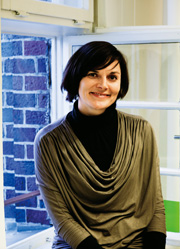 Julia Leihener
Julia Leihener
Creation Center Designer
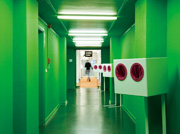 The entrance hall is deliberately painted in a bright green color – contrasting the rest of the historical building style – , in order to prepare visitors for a different set of mind.
The entrance hall is deliberately painted in a bright green color – contrasting the rest of the historical building style – , in order to prepare visitors for a different set of mind.
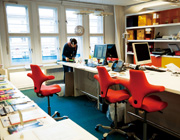 Area at standing height for hands on prototyping.
Area at standing height for hands on prototyping.
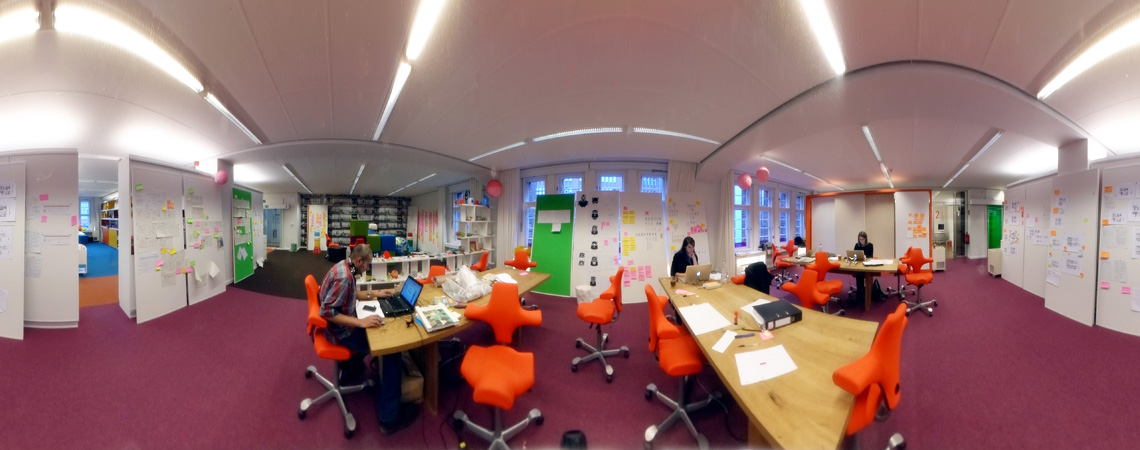
It is divided into separate areas by different carpet colors: green, orange, pink, brown, blue and grey etc. aiming for a change of change of mood.
 360°View
360°ViewIt is divided into separate areas by different carpet colors: green, orange, pink, brown, blue and grey etc. aiming for a change of change of mood.
*Touch Picture for 360° View<
To develop brand-new and innovative ideas, the office is designed in the way that brainstorming can occur organically for everyone who steps into this space. The use of colors is a good example. People would normally associate Deutsche Telekom with magenta. The thought-provoking use of different colors in this workspace is truly eye-opening.
The height-adjustable table in the meeting room is very popular. Also the height and angle of the chairs are adjustable —ideal design for long hours of discussions.
When one can shift positions naturally and comfortably, they can stay active, alert and in particularly a long meeting, can be kept from falling asleep. Sometimes discussion can be held with the participant standing at the table. This can bring out fresh ideas and fruitful discussions.
Inspirational Material Lab with an extensive collection of gadgets, including many from Japan, helps workshop participants to think outside the box. These are intended for right-brain stimulation and to encourage creativity and inspiration. For example, when working on a mobile music project, people tend to pick up headphones, a guitar or other musical devices from the Material Lab. Touching relevant objects to the project can flip the switch on in one’s mind, and this will often result in new ideas. All of the gadgets are marked with the QR code. Once the code is read, the database shows the explanation about the particular gadget.
Ideas born through this communication are quickly made visual through the use of boards and tags. This can make them the hint for further ideas, building a positive cycle in which one idea leads to another.
Many of the Deutsche Telekom managers are surprised by the number of gadgets. Some people simply do not understand the value of playfulness. There are some people who think they’ve come to a fairyland when they first arrive, but when the workshop is finished and it’s time to go home, they usually have a big smile on their face,” Ms. Leihener says. “It’s just very different from their usual way of working—it’s efficient and productive, in an easy, enjoyable environment that is organic – so in the end they are happy,”
The managers bring back with them the thinking method and tools of Creation Center to their departments. The understanding of design thinking has been growing in Deutsche Telekom. Now requests to Creation Center is increasing; such as the managers’ training for thinking and ideatization processes and the design thinking for the HR department. Its potential seems to be endless.
From WORKSIGHT 04(June, 2013)
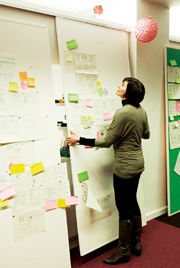 Many boards are set up throughout the office. Ideas are pinned up for display, or mounted on the railing set into the wall.
Many boards are set up throughout the office. Ideas are pinned up for display, or mounted on the railing set into the wall.
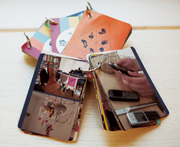 Inspirational cards for the workshop.
Inspirational cards for the workshop.
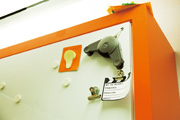 A scanner mounted on the workshop whiteboard.
A scanner mounted on the workshop whiteboard.


